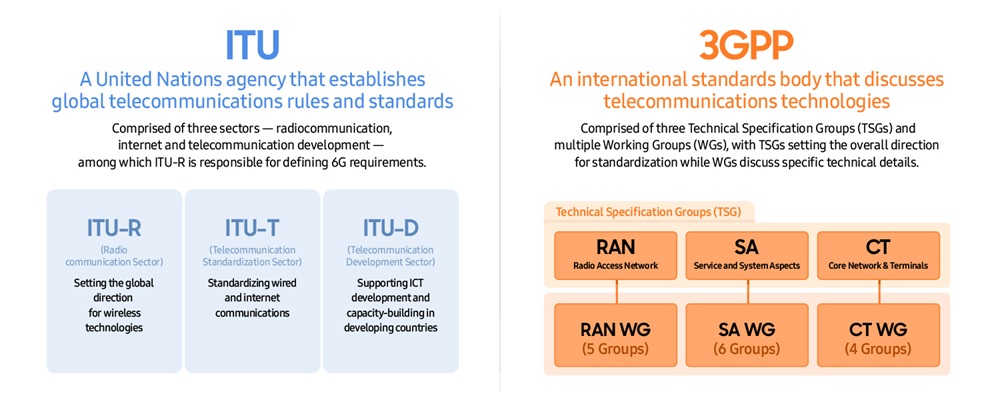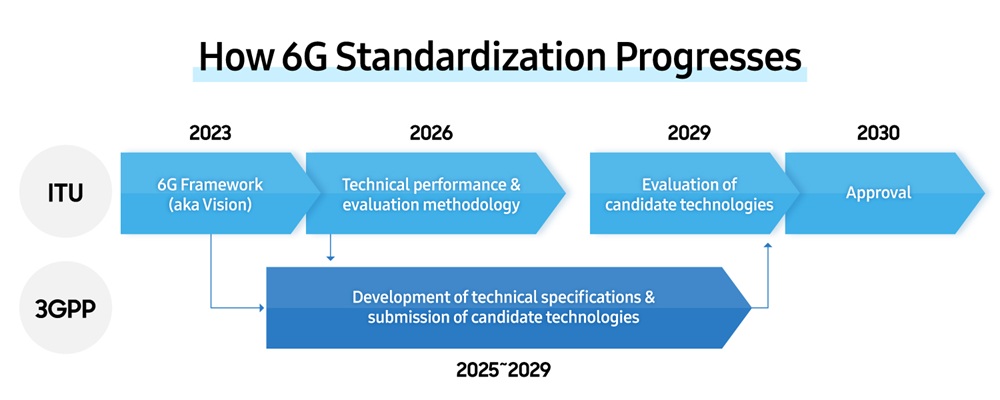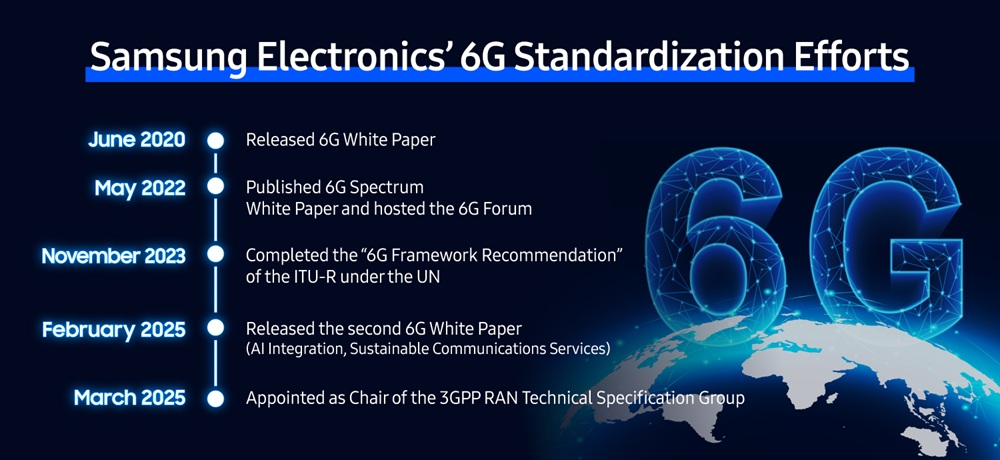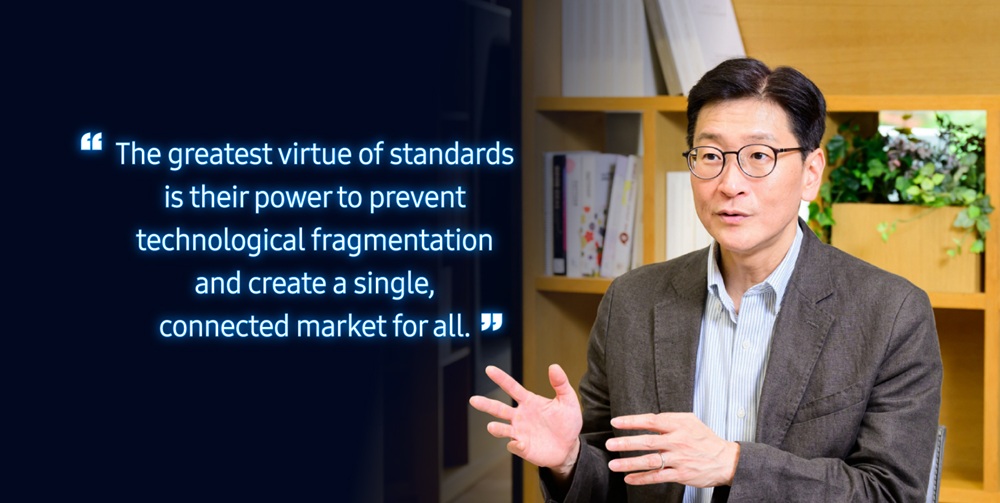Part one of the interview series covers Samsung’s leadership in 6G and global communication standards
Samsung Newsroom interviews Jin-Kyu Han, Vice President of the Tech Standards Research Team at Samsung Research
In the global mobile communications industry, standards are much more than just technical specifications — they are key drivers of the global market’s direction and technological leadership. As the world moves beyond 5G and accelerates toward 6G, attention is once again turning to the technological leadership behind global standardization.
Since 2020, Samsung Electronics has played a pioneering role in advancing next-generation communication technologies through active participation in international standardization efforts. This includes the publication of its 6G white papers and securing of key positions in major organizations such as the 3rd Generation Partnership Project (3GPP). At the May 2025 3GPP elections, Samsung secured additional leadership positions, reaffirming its distinct standing at the forefront of the industry.
To shine a light on this progress, Samsung Newsroom is launching an interview series with the leaders of the company’s communications business, which will introduce the current state of next-generation communications technology research and global standardization efforts. In part one of the Communications Leadership Interview series, the Newsroom sat down with Jin-Kyu Han, Vice President of the Tech Standards Research Team at Samsung Research, to discuss the current landscape and future outlook of 6G standardization, as well as Samsung’s strategies and vision.
▲ Jin-Kyu Han, Vice President of the Tech Standards Research Team at Samsung Research
International Standards for Seamless Communication Across Borders
Today, using our own smartphones to access roaming services while traveling abroad is something we often take for granted. This is a convenience that has only become truly seamless through the invisible promise of international standards — born from the collaboration of countless companies and experts around the world.
“Common protocols are essential for products and services from different companies to work together seamlessly,” explained Han. “In the mobile communications industry, where a diverse range of players — including smartphone manufacturers, network equipment vendors, telecom operators and semiconductor companies — are involved, standardization is an indispensable element. It plays a key role in uniting the world into a single market.”
Standardization serves as the backbone that drives the global communications industry toward a unified direction. “At technological inflection points like the transition to 6G, the importance of industry-wide discussions and consensus on standards becomes even greater,” Han emphasized.
Global Collaboration Driving 6G Standardization
How does global standardization actually function? Unlike initiatives driven by a single entity, global telecommunications standardization is built on a clear, step-by-step framework of collaboration. Two key players in this process are the International Telecommunication Union (ITU1) and the 3rd Generation Partnership Project (3GPP2).
“The ITU sets the direction for each new generation of communication technology, and based on that blueprint, the 3GPP works with global companies to define the technical details and carry out the standardization process,” explained Han.

▲ Overview of ITU and 3GPP
Global 6G standardization has now entered its launch phase. Following preliminary discussions on 6G technology directions that began in 2021, ITU-R officially announced the recommended framework for 6G standardization in November 2023. With the goal of finalizing 6G technical specifications by 2030, 3GPP plans to develop and propose a range of candidate technologies.
“3GPP took its first step toward 6G standardization by hosting a workshop in Korea this March,” explained Han. “6G study items were approved during its plenary meeting in June, and starting in the second half of this year, detailed technical discussions will begin within its Working Groups (WGs).”

▲ Key milestones and objectives of the ITU and 3GPP by year
The standardization of 6G is a shared journey in which the world works together toward a common goal. As standardization efforts gain momentum, companies worldwide are moving quickly to position their technologies within this framework, ensuring interoperability while developing solutions that meet market demands.
Samsung’s 6G Leadership: Driving Consensus Amid Fierce Competition
Countries and companies around the world are participating in discussions on next-generation communications standardization, each taking on specific roles. This process demands forward-looking leadership capable of both steering technological development and harmonizing diverse viewpoints—a role where Samsung Electronics has emerged as a central figure, simultaneously advancing innovation while building industry consensus.
Standardization is a continuous process marked by fierce competition among countless global stakeholders that aim to secure a lead in standards by having their own technologies incorporated. In this complex landscape, Samsung has consistently been elected to leadership positions within groups, earning recognition for its neutrality, credibility and coordination capabilities
“Samsung chaired the ITU-R’s 6G Vision Group, helping to establish the initial global vision for 6G and contributing to the design of its early roadmap,” explained Han. “We’re also leading discussions within 3GPP by serving as chairs and vice-chairs across various technical groups, steering the direction of standardization.”
Currently, Samsung Electronics holds a total of eight chair and vice-chair positions across 3GPP’s key Technical Specification Groups (TSGs). Han added, “In particular, the Radio Access Network (RAN) and System Architecture (SA) WG2 groups, where Samsung serves as chair, are central to shaping the structure and direction of 6G technologies. These groups are at the core of industry-wide technical discussions and the fact that Samsung chairs them is a testament to our influence.”

Samsung is also laying a solid technological foundation for standardization discussions through its pioneering research activities across various core 6G technologies. Since standardization only holds real value when it is backed by concrete technologies and practical feasibility, Samsung’s technological competitiveness contributes to making these discussions more effective.
“3GPP chairs are responsible for guiding discussions according to the timeline, while mediating and resolving various conflicts that arise during the standardization process,” Han explained. “Holding a significant number of chair positions is a clear sign that the mobile communications industry recognizes our technological capabilities and leadership.”
Key Focus Areas for Next-Generation 6G Research
As technical discussions within 3GPP begin in earnest this year, Samsung is concentrating its research on the core technologies necessary for 6G commercialization. At the heart of these discussions are three key phrases: AI integration, enhanced energy efficiency, and strengthened security.
“6G should deliver user-perceivable improvements, not just faster speeds or higher quality,” noted Han. “By applying AI technologies to network operations, we can automate complex processes while simultaneously reducing operational costs and improving service quality.”
“From the increasingly critical perspective of security and privacy, Samsung is also focusing on building safer communication systems while increasing system flexibility to easily and rapidly incorporate new services,” he added.

As we approach the 6G era — where technologies and services will connect seamlessly across national borders — international cooperation and coordination are more important than ever. In this evolving landscape, Samsung Electronics continues to play a leading role in shaping the global conversation on next-generation connectivity.
In part two of this series, Samsung Newsroom will explore the 6G standardization roadmap, key focus technologies and Samsung’s role as chair of the 3GPP TSG RAN, providing a closer look at the forefront of next-generation communications discussions.
1 Short for the International Telecommunication Union (ITU), a United Nations specialized agency dedicated to advancing information and communication technologies (ICT) and networks. Its work includes allocating radio frequencies, establishing technical standards, and supporting developing countries, while playing a vital role in fostering international cooperation in the global ICT sector.
2 Short for the 3rd Generation Partnership Project, an international collaborative initiative established to develop standards for mobile communication technologies. It primarily develops globally applicable specifications for mobile communication systems, including radio access networks, services and systems, core networks, and mobile devices.


